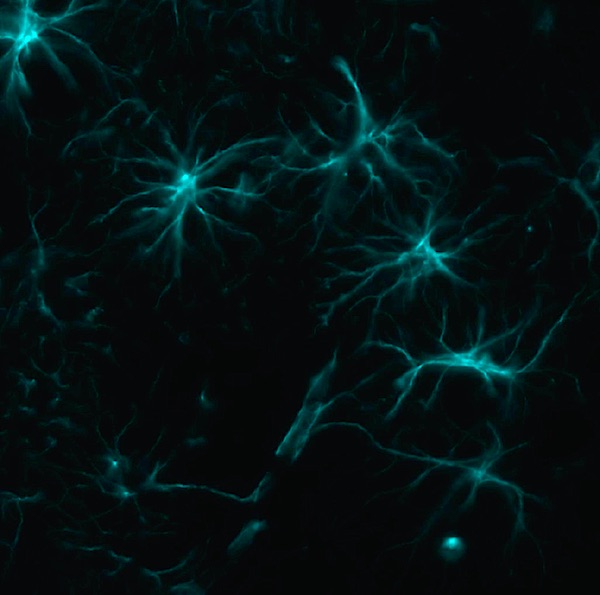If you live near the ocean, you may be familiar with the phrase “domoic acid poisoning.” Domoic acid accumulates in the shellfish and fish that consume marine diatoms – algae – which produce the powerful neurotoxin. Monitoring agencies examine samples of fish in an area, checking the levels of domoic acid, and issuing advisories if levels are too high.
However, even low levels of domoic acid can be harmful to humans and other animals. In the Microbiology and Environmental Toxicology (METX) program at UC Santa Cruz, PhD Candidate Emma Hiolski examines the effects of such low-level domoic acid exposure in humans.

"Astrocytes – a type of non-neuron 'helper' cell in the brain – can provide information on whether parts of the brain are healthy or injured. These are one of the markers I examine using microscopy to measure the effects of low-level domoic acid exposure." - E. Hiolski
“Although humans are well-protected from high-level exposures by seafood monitoring programs and regulations,” said Hiolski, “we do not know what may be happening in the brain with frequent low-level exposure (i.e., below the regulatory limit).”
“This is especially relevant for people that consume shellfish multiple times a week, including tribal communities along the coast of Washington State that subsistence harvest shellfish.”
Hiolski grew up far from the coast, land-locked in the Midwest, which she said spurred her fascination with the ocean. She attended college in Florida and while there she found an additional interest: “I was surprised by how much I liked my chemistry courses in college. These two interests finally meshed for me during an internship I did the summer before my senior year.”
Her internship at the NOAA Northwest Fisheries Science Center introduced her to Dr. Kathi Lefebvre. “The movement of domoic acid through marine food webs, and its neurological effects, was the primary research focus of my advisor,” she said. “I found her research to be a perfect link between biochemistry and ocean science for me.”

Emma Hiolski collecting water samples during her summer internship at NOAA Northwest Fisheries Science Center, 2008.
Graduating with a double major in Biochemistry and Marine Biology, and encouraged by her professors to continue her education, Hiolski came to the METX program at UC Santa Cruz. “I was excited about the interdisciplinary research focus of the faculty here, and Dr. Lefebvre received her Ph.D. from UCSC,” said Hiolski. “[Lefebvre] highly recommended the University, and I am even continuing to collaborate with her group in Seattle on my dissertation research.”
The METX program incorporates microbiology and toxicology foci in the doctoral program – there are three graduate programs within METX: the Master of Science, the Doctoral, and a doctoral Microbial Biology and Pathogenesis track incorporated with the Program in Biomedical Sciences and Engineering. Hiolski uses various methods of examination for her research. “I use a combination of genomics (measuring whether genes are turned on/off), microscopy, and electrical activity measurements to uncover small-scale changes in the brain caused by chronic low-level domoic acid exposure.”
“Understanding these changes is the first step towards determining whether domoic acid poses health risks to humans, and who might be most at-risk.”
In addition to coastal views from the lab, Hiolski also enjoys the camaraderie with other graduate students at UCSC. “Working with and meeting other graduate students has been the best part of being a grad student here,” she said. “Everyone I’ve met has been incredibly supportive and willing to share their knowledge and expertise. It is really wonderful to be part of such a collaborative environment.”
After completing her doctoral studies in spring 2016, Hiolski will continue her studies in the Science Communication certificate program at UCSC, moving forward in her quest to understand and explain the science around us. “I am passionate about making science fun, engaging, and accessible for everyone.”

